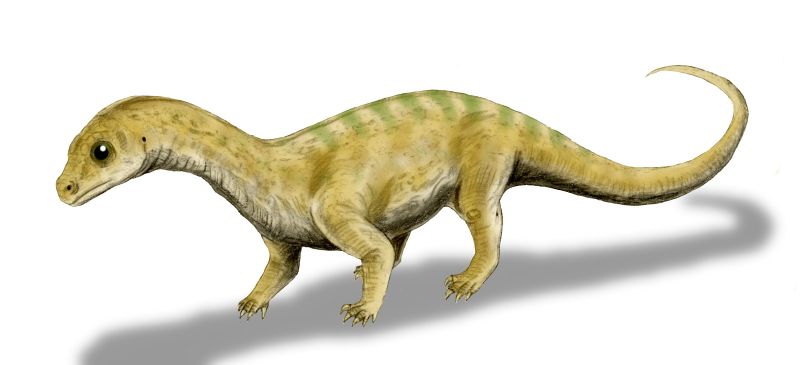[Recent Entries][Archive][Friends][User Info]
November 6th, 2012
| November 6th, 2012 | |
|---|---|
| 06:13 pm [industrialterro] [Link] |
Massospondylus Массоспондил, или Массоспондилус (Massospondylus) — растительноядный динозавр раннего юрского периода (от 200 до 183 миллионов лет назад), один из самых древних динозавров. Название происходит от греческого μάσσων (massōn, «длинный») и σπόνδυλος (spondylos, «позвонок»). Был описан в 1854 году сэром Ричардом Оуэном по останкам, найденным в Южной Африке и является одним из первых динозавров, получивших название. Ископаемые останки были обнаружены также в Лесото, Зимбабве, Намибии, в ЮАР, США и Индии. Массоспондилы имели длинные шею и хвост, взрослые особи достигали в длину 5 метров. Во взрослом возрасте массоспондилы могли ходить на задних ногах, используя передние лапы с большим когтем на каждой для защиты и захвата листьев, употребляемых в пищу. Для добывания пищи с верхушек деревьев служила и длинная шея. Детёныши массоспондилов передвигались на четырёх ногах. Согласно современным исследованиям, после рождения они ещё не были способны добывать пищу, в связи с чем об этом должны были заботиться взрослые особи. M. kaalae Barrett, 2009 — вид, живший в юрском периоде окоо 199—189 млн лет назад. Описан в 2009 году на основе частичного черепа. Ископаемые останки были найдены в местности Voyizane в формации Upper Elliot на территории Южной Африки; M. rawesi. The type species is M. carinatus; seven other species have been named during the past 150 years, but only M. kallae among these is still considered valid. Prosauropod systematics have undergone numerous revisions during the last several years, and many scientists disagree where exactly Massospondylus lies on the dinosaur evolutionary tree. The family name Massospondylidae was once coined for the genus, but because knowledge of prosauropod relationships is in a state of flux, it is unclear which other dinosaurs—if any—belong in a natural grouping of massospondylids; several 2007 papers support the family's validity. Although Massospondylus was long depicted as quadrupedal, a 2007 study found it to be bipedal. It was probably a plant eater (herbivore), although it is speculated that the prosauropods may have been omnivorous. This animal, 4–6 meters (13–20 feet) long, had a long neck and tail, with a small head and slender body. On each of its forefeet, it bore a sharp thumb claw that was used in defense or feeding. Recent studies indicate Massospondylus grew steadily throughout its lifespan, possessed air sacs similar to those of birds, and may have cared for its young. Massospondylus was a mid-sized prosauropod that was around 4 meters (13 ft) in length and weighed approximately 135 kilograms (300 lb), although a few sources have estimated its length at up to 6 meters (20 ft). Although long assumed to have been quadrupedal, a 2007 anatomical study of the forelimbs has questioned this, arguing that their range of motion precluded effective habitual quadrupedal gait. The study also ruled out the possibility of "knuckle-walking" and other forms of locomotion that would avoid the issue of the limited ability of Massospondylus to pronate its hands. Although its mass suggests a quadrupedal nature, it would have been restricted to its hind legs for locomotion. Massospondylus was a typical prosauropod in most other respects. It possessed a slender body and long neck, with around nine long cervical (neck) vertebrae, 13 dorsal (back) vertebrae, three sacral (hip) vertebrae, and at least 40 caudal (tail) vertebrae. The pubis faced forward, as with most saurischians. It had a slighter build than that of Plateosaurus, an otherwise similar prosauropod dinosaur. A recent discovery shows that Massospondylus possessed well-developed clavicles, joined in a furcula-like arrangement, suggesting both that it had immobile shoulder blades and that clavicles were not rudimentary and nonfunctional in those dinosaurs that did not have true furculae. This discovery also indicates that the furcula of birds is derived from clavicles. Like Plateosaurus, it had five digits on each foot, with a large thumb claw used for feeding or defense against predators. The fourth and fifth digits of the forepaws were tiny, giving the forepaws a lopsided look. The 2007 study indicated that Massospondylus held its manus (hands) in a semi-supinated ("prayer-like") orientation, with the palmar surfaces facing one another; the wrist was never found rotated in articulated (still-connected) fossil specimens. The small head of Massospondylus was approximately half the length of the femur. Numerous openings, or fenestrae, in the skull reduced its weight and provided space for muscle attachment and sensory organs. These fenestrae were present in pairs, one on each side of the skull. At the front of the skull were two large, elliptical nares. The orbits were proportionally larger in Massospondylus than in related genera such as Plateosaurus. The antorbital fenestrae, smaller than those seen in Plateosaurus, were situated between the eyes and the nose. At the rear of the skull were two more pairs of temporal fenestrae: the lateral temporal fenestrae immediately behind the eye sockets and the supratemporal fenestrae on top of the skull. Small fenestrae also penetrated each mandible. The shape of the skull is traditionally restored as wider and shorter than that of Plateosaurus, but this appearance may be due just to differential crushing experienced by the various specimens. Some features of the skull are variable between individuals; for example, the thickness of the upper border of the orbit and the height of the posterior maxilla. These differences may be due to sexual dimorphism or individual variation. ( Read More )
Размеры тела в сравнении с человеком:
Ископаемые останки (1, 2, 3, 4, 5, 6, 7, 8, 9, 10):
( Read More ) Tags: Вымершие рептилии, Юра, авеметатарзалии, архозавроморфы, архозавры, диапсиды, динозавроморфы, динозавры, завроподоморфы, массоспондилиды, прозавроподы, ящеротазовые |
| Previous Day | 2012/11/06 [Archive] |
Next Day |










